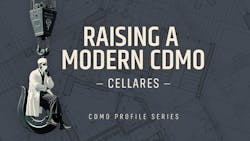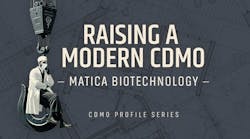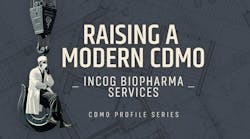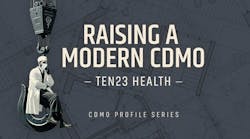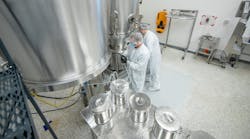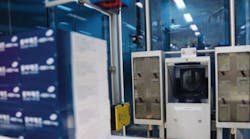Editor's note: This article ran as part of our annual CDMO profiles series, highlighting four young companies built to help pharma tackle the future of medicine.
Today’s pharma industry has a scaling problem — and Cellares wants to solve it.
The industry is facing a formidable crisis in the cell therapy space: groundbreaking scientific advancements are vastly outpacing pharma’s ability to manufacture them. With each cell therapy approval, the addressable patient population expands and the waitlist for cell therapies grows longer.
And for many patients, wait times can be the difference between life and death — it’s estimated that 20% of patients eligible for FDA-approved CAR-T cell therapies die awaiting treatment.
Recognizing that the traditional manual manufacturing model for cell therapies was ripe for disruption, Fabian Gerlinghaus and Omar Kurdi came up with an ambitious idea. In 2019, armed with a plan to build the sector’s first end-to-end fully automated manufacturing platform, Gerlinghaus and Kurdi launched Cellares, a new breed of CDMO.
“We saw an opportunity to save the lives of millions of people because cell therapy manufacturing capacity and scalability is just not where it needs to be and as a result, patients who are eligible for approved CAR-T cell therapies are dying needlessly,” says Gerlinghaus.
Gerlinghaus, an aerospace engineer turned tech inventor turned entrepreneur, has long been motivated by impact, and he went big when it came to Cellares.
“We’re very confident that we will deliver on our goal, which is to meet the total demand for cell therapies globally,” says Gerlinghaus.
The San Francisco-based company is the first to brand itself as an IDMO — an integrated development and manufacturing organization — promising to deliver in an area where traditional CDMOs have fallen short by taking an Industry 4.0 approach to commercializing today’s most cutting-edge medicines. The company, which revealed a blockbuster $255 million Series C funding round this past August, is backed by a suite of investors including cell therapy leader, Bristol Myers Squibb.
With two smart factories in the U.S., including its new commercial-scale plant in New Jersey, and near-future plans to break ground on a commercial facility in Belgium followed by one in Asia, the promising IDMO has set itself up to make an impact on both pharma clients and patients.
The scale of the problem
According to Gerlinghaus, if you want to create disruptive technology, you need to begin by understanding why disruption is needed.
“I think every good invention starts with a really good understanding of the problem. The problem that we’re facing in cell therapy manufacturing today is focused on scale, cost, quality and speed,” says Gerlinghaus.
Current methods of manufacturing cell therapies typically consist of dozens of hands-on processes, where cells are manually moved from one benchtop instrument to another in cleanroom environments. These methods have proven to be cumbersome, expensive and plagued with errors.
Despite an eligible patient population of over 450,000, Cellares estimates that only 4,000 commercial doses of CAR-T cell therapy were manufactured in 2021. With new approvals and drugs being extended into earlier lines of treatment, market forecasts predict that the addressable patient population for CAR-T therapies will be 2 million patients per year from 2025-2030. This means there is a huge capacity gap that needs to be closed.
Quality is also a contributing issue. According to Gerlinghaus, process failure rates in the current CAR-T space range between 15-30%. Not only is that inefficient from a business perspective, it also can cost patients their lives.
“We are mostly talking about autologous cell therapies and if you have a manufacturing failure, that patient may die before you get another chance to collect high-quality cells,” says Gerlinghaus.
But perhaps the biggest threat looming over the future of cell therapies is manufacturing cost. “Cell therapy right now is not competitive with other drug modalities from a financial and economic perspective within pharma companies,” says Gerlinghaus. “So we need to bring down manufacturing costs to make these personalized therapeutics sustainable, and turn this into a sustainable business for pharma companies.”
Measuring the impact of new tech
Aware of the multitude of challenges plaguing the cell therapy sector, Cellares first set its sights on tackling scalability and capacity.
“What does it take to increase scalability and capacity? First and foremost, automation and really high throughput. So those were two key requirements,” says Gerlinghaus.
The company’s core technology, known as the Cell Shuttle, automates the entire manufacturing process from start to finish.
The heart of the Cell Shuttle platform is its single-use closed cartridge. Starting materials from patients are loaded into the cartridges, which contain modules that integrate all the technologies needed for the cell therapy processing steps.
What’s more is that the Cell Shuttle can handle 16 cartridges, which means therapies for 16 patients, simultaneously. This equates to 800 batches per year per Cell Shuttle (7-day process) or 2,800 batches per year per Cell Shuttle (2-day process).
In addition to CAR-T, the platform can support therapies utilizing hematopoietic stem cells (HSC), T-cell receptors (TCR), natural killer (NK) cells, tumor-infiltrating lymphocyte (TIL) cells, regulatory T-cells (Tregs) and gamma-delta (γδ) T-cells.
Beyond solving scalability and capacity bottlenecks, the Cell Shuttle’s automated process all but eliminates two primary sources of process failure — contamination and operator error. In fact, Cellares says its technology offers 75% lower process failure rates when compared to conventional CDMOs using manual processes.
The assumption may be that utilizing cutting-edge technology like the Cell Shuttle comes at an exorbitant cost and that this cost will be absorbed by Cellares’ customers — but Gerlinghaus says the exact opposite is true. The Cell Shuttle drastically reduces the need for large facility footprints, as well as labor. And capturing these efficiencies allows Cellares to pass cost savings on to its customers.
“Normally when a pharma company outsources to a CDMO, their manufacturing costs go up. When they outsource to us, their manufacturing costs go down because of the efficiencies of the technology and our ability to offer a much lower price per batch,” says Gerlinghaus.
In fact, according to Gerlinghaus, Cellares charges customers 50% lower cost per batch than conventional CDMOs in the cell therapy space.
But the most impressive stat for Gerlinghaus comes in the form of productivity. The collective efficiencies of the Cell Shuttle mean that Cellares can offer unprecedented productivity levels in the cell therapy manufacturing space. And this, says Gerlinghaus, is what truly sets Cellares apart.
“What’s the key difference between an IDMO and a CDMO? To put it succinctly, it’s a 10x increase in productivity, meaning we can produce 10 times as many cell therapies with a facility of the same size and the same number of employees.”
Buying in to the future
It’s no secret that the pharma industry tends to be risk-averse when it comes to adopting new technology, so how does a young IDMO win the trust of pharma manufacturers? According to Gerlinghaus, the scope of the problem in cell therapies is so massive, that manufacturers are casting aside their circumspect ways and actively searching for solutions.
“Taking risks is usually not rewarded within large pharma companies,” says Gerlinghaus. “But the pain is tremendous. There are 1000s and 1000s of patients dying because pharma can’t produce enough drug products. At the same time, pharma companies are missing out on billions of dollars in revenue. It’s such a huge issue for both patients and pharma companies and it’s going to get worse with more and more cell therapy approvals, cell therapies getting approved for earlier lines of treatment, and cell therapies getting approved for indications with larger patient populations.”
But buy-in from other pharma companies hasn’t hurt either.
Cellares initially set up a low-risk, low-cost program to generate proof of concept for the Cell Shuttle. The Technology Adoption Partnership (TAP) program enabled companies to transfer their cell therapy processes onto the Cell Shuttle to evaluate potential benefits in capacity, process failure rates and manufacturing costs.
The program, which can be completed in six months or less, attracted companies like investor Bristol Myers Squibb, Cabaletta Bio and Lyell Immunopharma. The TAP program was so successful that Cellares is sunsetting it at the end of the quarter in favor of traditional CDMO supply agreements.
“We had a really strong influx of cell therapy companies wanting to work with us and that trend is not slowing down. We’re continuing to sign deals left and right,” says Gerlinghaus.
Gerlinghaus is all-in on the Cell Shuttle technology and the impact he foresees it will have on Cellares’ growth, the cell therapy industry as a whole and most importantly, patients.
“The way you build a $100 billion company is by making a big bet on cell therapies. Then you build strongly differentiated technologies and vertically integrate to operate them yourself. In this way, we’ll proceed to save the lives of millions of people over the next decade.”
